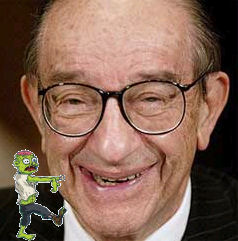
|
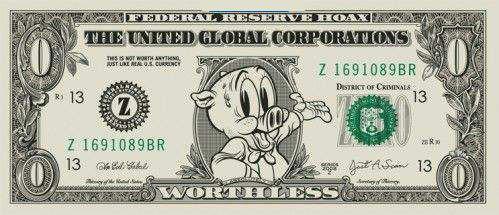

"When Larry Summers, Obama's chief economic
advisor, piously tells us that the administration's hands are tied because we
all must abide "by the rule of law,"
perhaps it's time to ask: What rule
and for whom?"
Tim Rutten March 18, 2009 LA Times

Economics is defined
as:domestic
management
theory and
management of economic
systems
"Karl Marx, whose
economic analyses are strikingly
prescient, saw how the credit economy is one way that
central banking systems
attempt to stretch out and soften
the boundary in which the private
accumulation of profit from production runs up against the waning
purchasing power of
consumers.
In a nation whose
governing parties and
increasingly wealthy corporate
elite can't restrain
themselves from devastating and
costly imperialist wars overseas while at the same time
impoverishing ever-growing numbers
of the struggling and poor at home." - Eric Brill 01/08
"Wherever
politics intrudes upon economic life, political success is readily attained by
saying what people like to hear rather than
what is demonstrably true. Instead
of safeguarding truth and honesty, the State then tends to become a
major source of insincerity and mendacity." – Hans F.
Sennholz
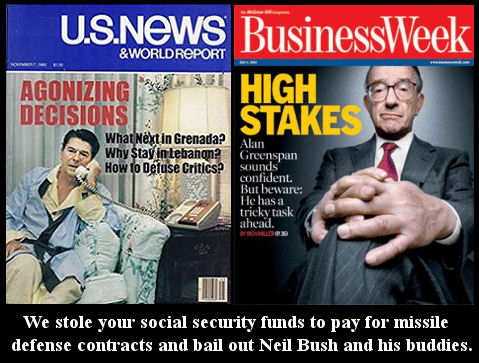
savings and loan debacle
The savings and loan debacle
began the regression of the American
republic into a "plutonomy" - a society in which
the largest economic gains flow to an
ever smaller portion of the population creating a decadent
social order that poorly rewards human
labor.
After the stockmarket
crash of 1929, Congress passed a series of laws designed to
restrict the ability of Wall Street to
manipulate markets.
1933 Glass-Steagall Act
Congress passes the
Glass-Steagall Act
separating commercial banking activity - savings and checking accounts, which
accepted wages as deposits
and issued small business loans and mortgages, from
investment banking activity, which
underwrote stocks and
corporate
bonds.
This is the governing economic principle for more than half a
century.
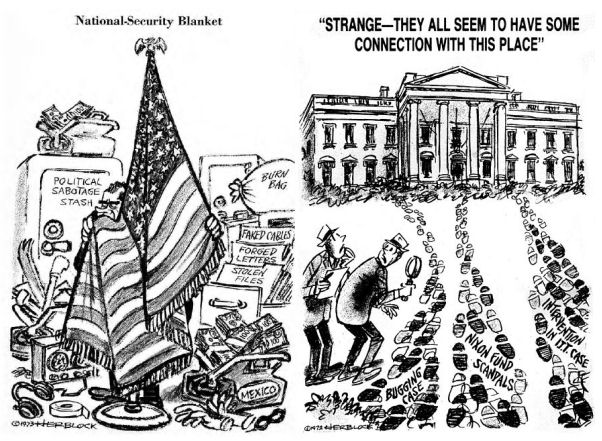
1971
Nixon
Shock
Richard Nixon consulted
Federal Reserve chairman Arthur Burns, incoming
Treasury Secretary John
Connally, and then Undersecretary for International Monetary Affairs and future
Fed Chairman Paul Volcker.
On the afternoon of Friday, August 13, 1971,
Nixon, on the advice of the
Connally, decided to break up Bretton Woods by announcing the
following actions on August 15:
Nixon directed Treasury Secretary
Connally to suspend, with certain exceptions, the convertibility of the dollar
into gold or other reserve assets, ordering the gold window to be closed
such that foreign governments could no
longer exchange their dollars for gold.
Nixon issued
Executive Order 11615 (pursuant to
the Economic Stabilization Act of 1970), imposing
a 90-day freeze on wages and
prices in order to counter
inflation.
This was the first time the U.S. government had enacted wage
and price controls since World War II.
An import surcharge of 10 percent was set to ensure that American
products would not be at a disadvantage because of the expected fluctuation in
exchange rates.
Speaking on television on Sunday, August 15, when
American financial markets were closed, Nixon said the following:
"We
must protect the position of the American dollar as a pillar of monetary
stability around the world.
In the past 7 years, there has been an average of one international
monetary crisis every year.
I have directed Secretary Connally to
suspend temporarily the convertibility of the dollar into gold or other reserve
assets, except in amounts and conditions determined to be in the interest of
monetary stability and in the best interests of the United States."
Simon Kuznets awarded the
Sveriges Riksbank Prize in
Economic Sciences in Memory of Alfred Nobel.
Kuznets curve
expresses the hypothesis as an economy develops, market forces first increase
and then decrease economic inequality.
The Kuznets curve appeared to be
consistent with experience at the time it was proposed.
According to
estimates put forward by Thomas Piketty
inequality has now returned to the levels of the late 19th century.
1973 Wassily Leontief awarded the
Sveriges Riksbank Prize fo input-output analysis which shows the process by
which inputs in one industry
produce outputs for consumption or for input into another industry.
The
matrix devised by Leontief is often used to
show the effect of a change in
production of a final good on the
demand for inputs.
Although the table is useful as a rough
approximation of the inputs required, economists know from mountains of
evidence that proportions are not fixed.
Specifically, when the cost of
one input rises, producers reduce their use of this input and substitute other
inputs whose prices have not risen.
If wage rates rise, for example,
producers can substitute capital
for labor and, by accepting wasted materials, can even substitute raw
materials for labor.
That the input-output table is inflexible means
that, if used literally to make predictions, it will necessarily give wrong
answers.
1977 George Herbert Walker Bush hired
by First International.
1978 First International fails and requires a $3.5
billion federal bailout.
Summary
Of The International Banking Act Of 1978
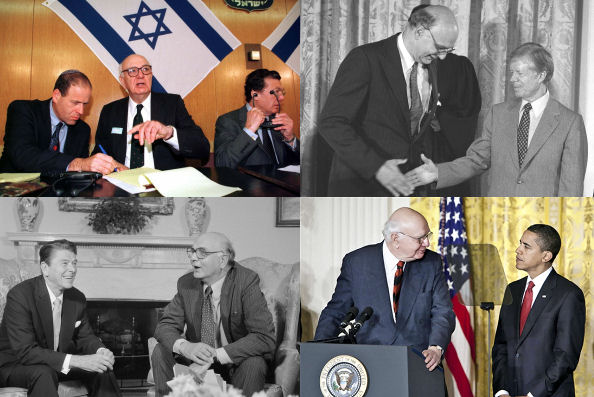
August
1979 Paul Adolph Volcker attempts to reign in the
money supply, and
inflation, by
raising interest rates to
stratospheric heights.
Most savings and loans fixed rate assets rate
of return are considerably below the prevailing rate of Federal Reserve
funds.
Savings and loans are paying, assume 12%, for loan capital but
their return on previous released capital is only 6%.
This policy
basically obliterates the Savings and Loan industry.
"The local
manufacturing sector never came back after the calamitous decline produced by
the Paul Volcker recession of 1979-1983, when
interest rates were deliberately raised
to over 20% to kill off family businesses so that global corporations could
step in and take over." - Richard C. Cook
December 12,
1980
Federal Reserve chairman Paul Adolph Volcker
BB /
CFR /TC raises the prime loan rate to
21.5%.
Deregulation
legislation is proposed to address the low rate of return of an investment
portfolio full of long-term, low fixed-rate assets.
Savings and
loans are given additional investment opportunities and adjustable rate
mortgages are allowed.
Wall
Street now sees the savings and loan industry as a "cash cow" to be "levered"
accordingly.
"I was working in the Carter
White House in
1979-80.
Paul Volcker,
a Rockefeller protégé,
suddenly raised interest
rates to fight inflation the bankers caused by the
OPEC oil price deals creating
a recession.
Through the "Reagan
Revolution" regulatory controls over bank loans were lifted allowing banks
to use fractional
reserves for consumer loans.
Volcker's
recession shattered American manufacturing and hastened the flight of jobs
abroad.
Under the "Reagan
Doctrine," the US embarked on a
mission of world conquest,
attacking one small
nation at a time, starting with
Nicaragua.
Global capitalism was on the
march, with the US armed forces its
own private police force." -
Richard C. Cook
Nancy Teeters, the lone dissenter
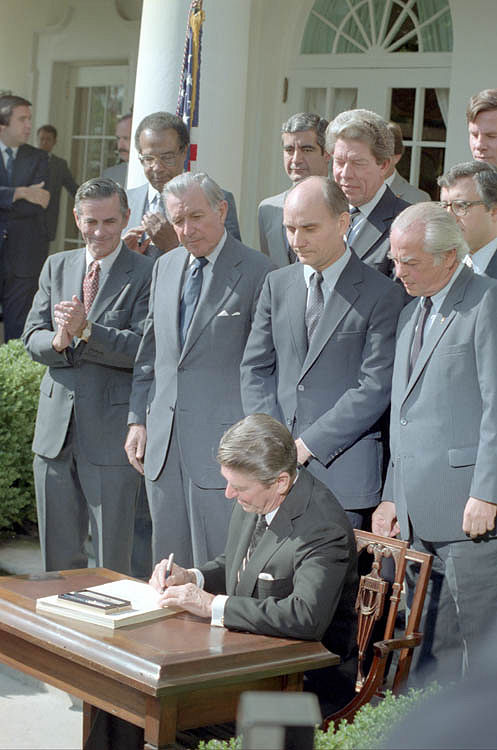
"People
think the Federal Reserve central
bank is US government
institution.
It is not a
government institution.
It is
a private credit monopoly of
those who prey upon the
people of the US for the benefit of themselves and their foreign customers;
foreign and domestic speculators and swindlers; and rich and predatory money
lenders.
Twelve private credit monopolies were deceitfully foisted upon
this country by bankers who came here
from Europe and who repaid us for our hospitality
by undermining our American institutions." -
Louis T. McFadden, House
Banking Committee Congressional Record, pg 1295 & 1296, June 10,
1932
1982 Gain-St Germain Depository Institutions Act
deregulation legislation
expands acceptable savings and loans investments by permitting savings and
loans to make short term consumer loans, issue
credit cards, and make
commercial real estate loans.
This was the method of stoking commerce after dumping water on the
entire economy by increasing the prime loan rate to 21.5% on December 12,
1980.
Financial
engineers claim broader investment opportunities will allow savings and loans
to better diversify their portfolios enabling financial stabilty.
Beginning from a situation where
liabilities exceed assets, financial managers cannot overcome shortages by
pursuing a conservative investment course.
This provided
the means for increased risk
taking while ignoring the need for future capital investments by lowering
capital requirements.
With revised accounting rules to artificially
boost reported fractional
reserve equity savings and loans began to look for new investment
opportunities.
Once the interstate lending rules had been suspended the
preferred method became raising rates paid on certificates of deposits - CDs -
to garner more deposits and to
make new investments promising still higher returns.
In the past
depositors had no reason to send funds to savings and loans halfway across
America but rapidly advancing computer technology - the overnight transfer -
changed that by making possible a nationwide market in deposits while the
higher rates made it worth the trouble.
The Federal Deposit Insurance Corporation
(FDIC) preserves and promotes public
confidence in the US financial system by insuring
deposits in banks and
thrift institutions for at least
$250,000.
Are All Bank Accounts Insured by the FDIC?
Federal
deposit insurance put insolvent
institutions in a position to abuse the new market as federally insured
depositors are unconcerned about the health of the institutions in which they
placed their money.
Undercapitalized savings and loans assured
themselves a continuous inflow of capital by simply offering to pay
higher interest rates than
competitors.
Healthy savings and loans are asked to pay increasing
deposit insurance premiums to protect depositors in failed institutions and
consequently gain little or no cost advantage from the fact they are well
capitalized.
Funds flow from stronger banks and savings and loans to the
weakest banks.
1986
The movement to use the
Federal Reserve Board to
kill Glass-Steagall
begins.
Federal Reserve
Board reinterprets existing law to allow commercial banks to derive a
minuscule 5% of their revenues from
investment banking
activities.
1989 Alan Greenspan bumps
investment banking
activities up to 10%.
1996 Through creeping
incrementalism Alan Greenspan kills Glass-Steagall when he ups the limit
investment banking activities to 25%.
July 1999 Larry
Summers is appointed Treasury Secretary when
Robert Edward Rubin leaves to become
Vice Chairman of Citigroup.
Larry Summers is
directly responsible for the financial institution meltdown.
As
William Jefferson Clinton' Treasury Secretary from July 1999 - January 2001 he
shaped the financial deregulation that unleashed the crisis.
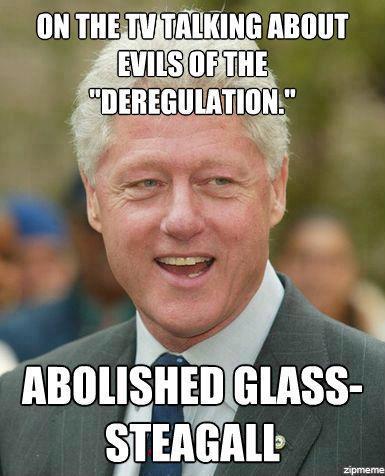
"Scores of banks failed in the
Great Depression as a
result of unsound banking practices. Their failure deepened the crisis. Glass-Steagall was
intended to protect our financial system by
insulating commercial banking from
risk. It was one of several stabilizers designed to keep a similar tragedy
from recurring. Now Congress is about to repeal that economic stabilizer
without putting any comparable safeguard in its place." -
Paul Wellstone
"If we got a return to positive growth - an economy
growing at 1% would be an economy with rising unemployment. I don't think we
can hold out the prospect we'll stabilize at the current level." - Larry
Summers 4/9/09
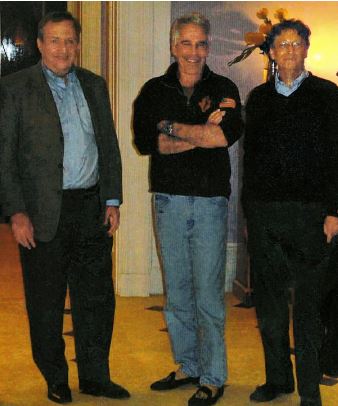
November 12,
1999
Gramm-Leach-Bliley Act officially repeals the Glass-Steagall Act of
1933.
The merger
of commercial and investment banking once again allows
investment bankers to use FDIC
insured personal commercial
deposits to purchase "financial
instruments" from hedge
funds.
2000
Short sellers attempt to profit
from an predicted decline in the
fungible asset
valuation of the value of
a fungible
financial instrument.
Short sellers take loans on
fungible financial
instruments - bonds,
marketable securities,
futures contracts,
securitized loans,
collateralized debt
obligations.
The
short seller is betting on being
able to purchase identical
fungible security
instruments at a lower price shortly before the loan comes due.
Profit
comes when the fungible financial instrument declines in value.
Larry
Summers backs the Commodity
Futures Modernization Act.
Larry Summers directly profits from
the deregulation by vigorously advising DE Shaw and Taconic Capital
Advisors in hedging strategies.
Larry Summers circle of friends
include the hedge fund managers Nancy Zimmerman, Laurence D. Fink, Kenneth D.
Brody, Frank P. Brosens, H. Rodgin Cohen, Orin S. Kramer, Ralph L. Schlosstein
and Eric M. Mindich.
Larry Summers
later has Harvard purchase
interest rate swaps while president of Harvard that end up costing
Harvard over $1
billion.
"The SEC's best estimate is that there are now approximately
8,800 hedge funds, with approximately $1.2 trillion of assets.
If this
estimate is accurate, it implies a remarkable growth in
hedge fund assets of almost
3,000% in the last 16 years.
Hedge funds are becoming more active in
such varied activities as the market for
corporate control, private
lending, and the trading of crude
petroleum.
Hedge funds account for about 30% of all US equity
trading volume.
Investment strategies or operations of
hedge fund include their use of
derivatives trading, leverage, and short selling.
The number of
enforcement cases against hedge
fund advisers has grown from just four in 2001 to more than 90 since then.
These cases involve
hedge fund managers who
misappropriated funds assets;
engaged in insider trading;
misrepresented portfolio
performance; falsified their
experience and credentials; and lied
about past returns." - Securities and Exchange
Commission Chairman Christopher Cox, July 25, 2006
"The mistake
most people make in looking at the financial crisis is thinking of it in
terms of money, a habit that might lead you to look at the unfolding mess as a
huge bonus-killing downer.
Looked at it in
purely Machiavellian terms,
what you see is a colossal power grab that threatens to turn the US government
into a kind of giant
Enron - a huge, impenetrable black box
filled with self-dealing insiders." - Matt Taibbi
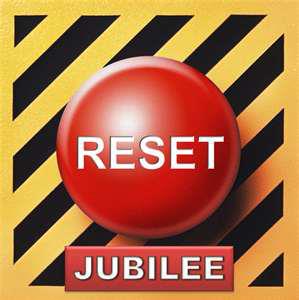
speech delivered by Mr Jaime Caruana,
General
Manager of the BIS
"Tight residential real estate markets and low
mortgage rates fueled a five-year
property boom as the number of US households paying more than half their
incomes for housing jumped from 13.8 million in 2001 to 17.9 million in 2007."
- Brian Louis
"Between 1999 and 2004, more than half the states,
both red (North Carolina, 1999; South Carolina, 2004) and blue (California,
2001; New York, 2003), passed anti-predatory-lending laws.
Georgia lite
a firestorm in 2002 when it sought to hold Wall Street gamblers of
mortgage-backed securities responsible for mortgages that were fraudulently
conceived.
Beginning in 2004 Michigan and forty-nine other states
battled the US Comptroller of the Currency and the banking industry (and
The Wall Street Journal editorial page) for
the right to examine the books of
Wachovia's mortgage unit, a fight the
Supreme Court decided in
Wachovia's favor in 2007 - about a year before it cratered." - Dean
Starkman
1863 National Bank Act establishes the
Office of the Comptroller of the Currency as part of the Treasury Department and a
system of nationally chartered banks.
The Office of the
Comptroller of the Currency examines the books of national banks to make
sure they are balanced.
"Several years ago, state attorneys general
and others involved in consumer protection began to notice a marked increase in
a range of predatory
lending practices by mortgage lenders.
In 2003 the OCC invoked a
clause from the 1863 National Bank Act to issue formal opinions preempting
all state predatory lending laws, thereby rendering them inoperative.
The OCC also promulgated new rules that prevented states from
enforcing any of their own consumer protection laws against national banks.
The US government's actions were so egregious and so unprecedented that
all 50 state attorneys general, and all 50 state banking superintendents,
actively fought the new rules.
But the unanimous opposition of the 50
states did not deter, or even slow, George Walker Bush in his goal of
protecting the banks.
In fact, when my office opened an investigation
of possible discrimination in mortgage lending by a number of banks, the OCC
filed a federal lawsuit to stop the investigation." - Elliot Spitzer, Washington Post, February 13,
2008
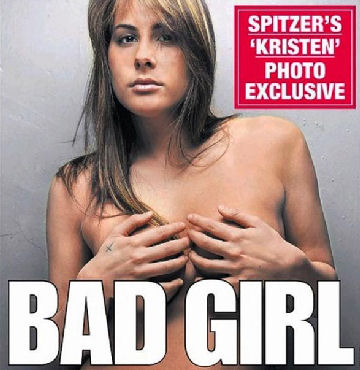
On the afternoon of February
13 federal agents of the Office of the Comptroller of the Currency staked out
Elliot Spitzer's hotel in Washington.
Elliot Spitizer's
dalliance with a
prostitute became headline news March 10.
Corporate news never questioned the
actions of the federal agents.
"One is struck by the similarities with the
Savings and Loan scandal which was allowed to continue through the 1980s, long
after it became apparent that deliberate bankruptcy was being used
by unscrupulous profiteers.
The long drawn-out housing bubble of
the current George Walker
Bush decade, and particularly the
derivative bubble that was
floated upon it, allowed the Bush administration to help offset the
trillion-dollar-plus cost of its Iraq
misadventure." - Peter Dale Scott
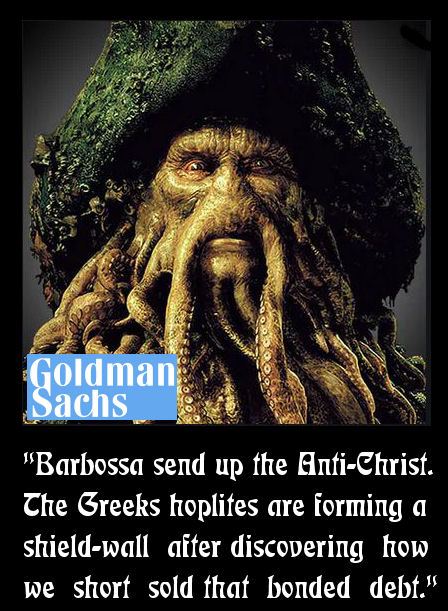
investment bank meltdown
"The injunction of Jesus to love others as
ourselves is an endorsement of self-interest." -
Brian Griffiths, Goldman Sachs PR
"We see TARP as an insurance policy. No matter how
bad it gets, we're going to be one of the remaining banks."- John C. Hope III,
Whitney National Bank chairman 1977 AL Williams establishes its base by mass-marketing
the concept of "Buy Term and Invest the Difference."
AL
Williams suggests its middle-income client base purchase sufficient
protection with term life insurance to systematically save and invest in
separate investment vehicles, such as mutual fund Individual Retirement
Accounts.
AL Williams is initially established as a
privately held general agency, at first selling term life insurance policies
underwritten by Financial
Assurance.
Facing a capital crisis Kuhn & Loeb merges with Lehman Brothers, to
form Lehman Brothers, Kuhn, Loeb Inc.
Internationally known as
Kuhn Loeb Lehman Brothers Inc.
1980 AL
Williams enters into a
contract with Boston-based Massachusetts Indemnity and Life
Insurance (MILICO), a larger
underwriter of life
insurance, whose parent is PennCorp Financial Services, Santa
Monica.
1981 John H.
Gutfreund orchestrates the sale of Salomon Brothers to the commodity
trading firm Phibro.
Salomon is noted in the
bond market for selling
mortgage-backed securities, a hitherto obscure species of financial instrument
first created by Ginnie
Mae.
Salomon begins purchasing home mortgages from thrifts and
packaging them into mortgage-backed
securities then sold to local and international investors.
First American National Corporation is
established as a holding company for First American Life Insurance
(rebranded AL Williams Life Insurance) and First American National
Securities (rebranded PFS Investments).
Shearson is
acquired by American Express and operated as a subsidiary.
1982 First American National Corporation, rebranded
The AL Williams Corporation, begins underwriting public stock
offerings.

1983
The AL Williams Corporation is listed on the NASDAQ exchange under ALWC.
American Can and PennCorp Financial Services
merge.
1984 Shearson
merges with Lehman Brothers, Kuhn, Loeb Inc. evolving into Shearson
Lehman.
Original Phibro CEO David Tendler is replaced by John
H. Gutfreund.
"The move puts Mr. Gutfreund, who is 54 years old, at the
helm of a two- pronged company with $42 billion in assets, $30 billion in
revenue, $617 million in annual profits, 6,700 employees and 25,000
shareholders. It has the capability of trading virtually anything, from wheat
to mortgage-backed securities." - Michael Blumstein, After the coup at
Phibro-Salomon 8/12/84
1986 Sanford Weill,
scion David-Weill family, purchases Commercial Credit from Control
Data for $7 million.
Lazard Freres - the biggest investment bank in
France - is owned by Lazard and
David-Weill families - old Genoese banking scions.
1987 86-year-old American Can announces a name change
to Primerica Corporation.
Primerica Corporation completes
a hostile takeover of Smith
Barney.
Sanford Weill acquires Gulf Insurance.
1988 Commercial Credit acquires Primerica
Corporation for $1.54 billion.
Shearson Lehman acquires EF
Hutton to be Shearson Lehman Hutton.
1989 Sanford Weill acquires retail brokerage
Drexel Burnham
Lambert.
Eight Charged in $50-Million Car Loan Fraud
1991 Primerica Corporation changes the name of AL
Williams to Primerica Financial Services.
US taxpayers,
already billed over $500 billion dollars for the S&L looting, are charged
another $70 billion to bail out the depleted FDIC.
US
taxpayers foot the bill for a secret 2 1/2-year rescue of
Citibank, close to collapse
after the Latin American debt crunch.
The Saving of Citibank
John S. Reed, chairman and CEO
of Citicorp, engineered a radical change in a major operating group,
built a lucrative new business from scratch, and played a high-visibility role
in the pivotal issue of Third World debt.
Citicorp Faces the World: An Interview with John
Reed
(The Washington
Post article above implies that the problem was domestic when clearly
the problem revloved around Third World debt.)
1993 Primerica acquires Travelers Insurance and
adopts the name Travelers.
Sanford Weill purchases Shearson
Lehman Hutton from American Express for $1.2 billion.
Shearson Lehman Hutton acquires Colorado-based lender, Aurora
Loan Services, an Alt-A lender.
1994 Sanford
Weill spins Lehman Brothers out of American Express.
The
CEO is
Richard Severin Fuld
Jr.

1995
Travelers becomes The Travelers Group.
1996 The Travelers Group purchases the property and
casualty business of Atena.
1997
Timeline of the Asian financial crisis
1998 Citicorp and Travelers merge and form the
behemoth Citigroup.
Travelers aquires Salomon and
merges it with Smith Barney creating Salomon Smith
Barney.
Citibank schemed with firm to hide its woes: Ex-Dewey
partner
2000 Shearson Lehman Hutton
purchases West Coast subprime
mortgage lender BNC Mortgage LLC.
BNC Mortgage LLC
quickly becomes a force in the subprime market.
September 11, 2001 Salomon Smith Barney is by far the
largest tenant in 7 World Trade
Center, occupying 1,202,900 sq ft (111,750 m2) (64% of the building) which
included floors 28–45.
Shearson Lehman Hutton occupies
three floors of World Trade
Center where one employee dies.
2002
Citigroup spins off Travelers Property and Casualty.
2003 Shearson Lehman Hutton makes $18.2 billion in
loans and ranked third in lending.
2004
Shearson Lehman Hutton makes over $40 billion.
Shearson
Lehman Hutton has morphed into a real estate hedge fund disguised as an
investment bank.
2005 Goldman Sachs receives
approximately $1.6
billion in taxpayer subsidies (Liberty Bonds) from New York City and state
taxpayers to finance a new headquarters near the World Financial Center in
Lower Manhattan.
2006
Aurora and BNC are lending almost $50 billion per
month.
Goldman Sachs changes its corporate structure into a bank
holding company.
Employees earn an average of $622,000 on a profit of
$9.4 billion.
Much of the commercial paper wealth is made on
takeovers and leveraged
buyouts.
Goldman Sachs employees:
George Herbert Walker Bush
(Lehman);
Robert
Zoellick (World Bank BB CFR
TC);
Henry Paulson (US Treasury Secretary);
Robert Rubin* (US Treasury Secretary,
Chairman Citigroup);
John Thain ( Merrill Lynch, Chairman NYSE);
Henry H.
Fowler, (US Treasury Secretary);
Edward Lampert (hedge fund manager);
Michael Cohrs (Global Banking at Deutsche Bank);
Mark Carney (Bank of
Canada);
Robert Steel (CEO of Wachovia);
Ed Liddy (CEO of AIG);
Neel Kashkari;
Gary Gensler (Commodity Futures Trading
Commission);
Stephen
Friedman (Chairman Intelligence Oversight Board,
Memorial Sloan-Kettering, Aspen
Institute, CFR, Brookings
Institution, Federal Reserve Bank of
New York.
Barack Obama
receives $981,000 for his
campaign from Goldman
Sachs.
2007 4th quarter Citigroup posts a
$10 billion loss, 21,200 Citigroup
employees are laid off.
Citigroup's single largest shareholder becomes Abu Dhabi Investment
Authority, the investment arm of Abu Dhabi government, with a $7.5 billion
injection of capital in late 2007 in exchange for a 4.9% stake which pays a
$1.7 billion a year dividend.
The second largest Citigroup shareholder,
with a 3.6% stake, is now Kingdom Holding incorporation owned by Prince
Al-Waleed bin Talal of Saudi
Arabia.
$6.88 billion of prefered stock is sold to an investment
fund controlled by the government of Singapore.
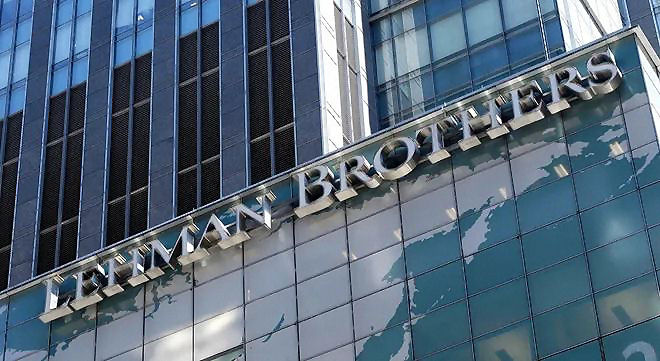
March through
September
2008
Five largest
investment bankers go bankrupt.
March
2008 Lehman Brothers assets of $680 billion are supported by
$22.5 billion of firm capital.
From an equity position, its risky
commercial real estate holdings are three times greater than capital.
In such a
highly leveraged structure, a 3 to 5% decline in real estate values wipes
out all capital.
Federal
Reserve sells Bear
Stearns at a discount to JP Morgan Chase for ten dollars per
share, far below the previous 52-week high of $133.20 per share.
June 2008 Merrill Lynch seizes $850
million worth of the underlying collateral from Bear Stearns but only
recoups $100 million in auction.
Merrill Lynch is given to Bank of America for $50 billion or
$29 per share.
The market valuation of Merrill Lynch was $100 billion
one year earlier.
During the final quarter of 2008 Merrill Lynch
loses $15.3 billion.
August 2008 Morgan Stanley is contracted
by the Treasury Department to
advise the government on potential rescue strategies for Fannie Mae and Freddie Mac.
September 21, 2008 Federal Reserve allows Morgan
Stanley to change its status from
investment bank to bank
holding company in order to survive.
November 23,
2008 Fed and Treasury announce a rescue package for
Citigroup to provide insurance against large losses on bundled
securities of $306 billion backed by residential and commercial real
estate.
Citigroup agrees to absorb the first $29 billion in
losses on the securities and derivatives; the Fed agrees to
cover 90% of losses exceeding that figure.
Citigroup
spends $1.77 million on lobbying
fees in the fourth quarter.
"Citigroup, like many others,
had sought to insure itself against losses with a variety of transactions,
including the purchase of insurance, only to learn that the losses were
overwhelming those who had promised to pay.
Insurance on the assets was
issued both by the bond insurers and by others that wrote what were known as
credit default swaps,
which amounted to insurance but were not regulated in the same way.
Those who wrote large amounts of such insurance are now in trouble,
either negotiating to pay claims for less than promised or, in the case of the
AIG, still in business only because of a government bailout.
The
AIG officials responsible for writing the swaps told investors they
would never suffer any losses." - Floyd Norris, November 24,
2008
"Sovereign wealth funds operated by
China, Singapore, Abu Dhabi,
and other countries have taken large equity stakes in Citigroup,
Merrill Lynch, Morgan Stanley, and other firms, including leading
European financial institutions." - Mark Jickling
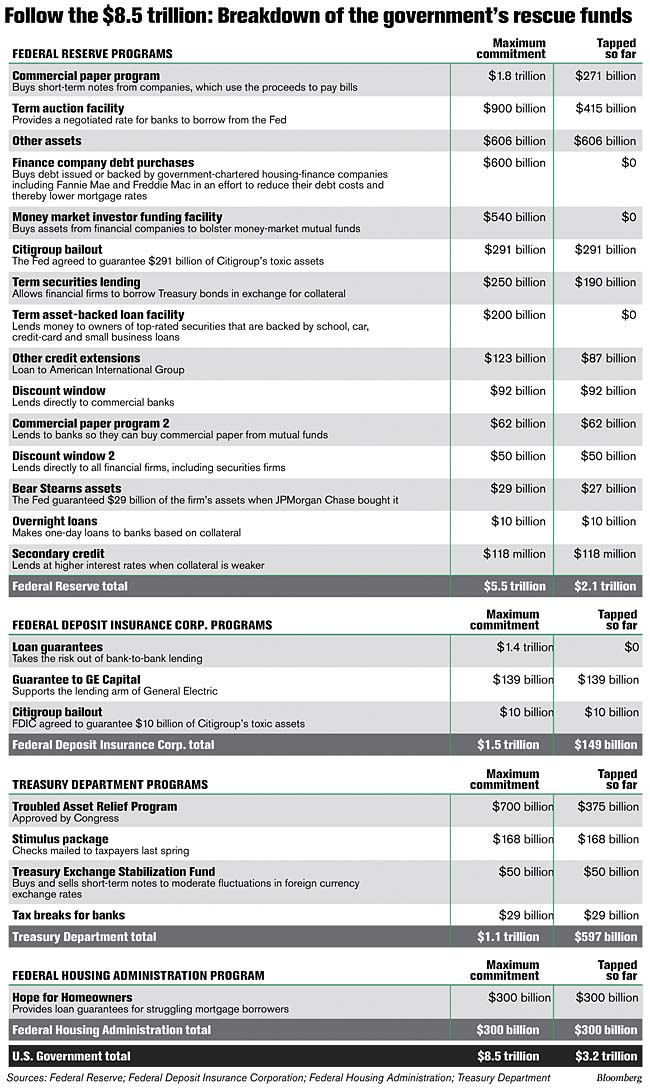
"With Long-Term Capital Management
bailout as a precedent, creditors saw loans to
unsound financial institutions would
be made good by the Fed - as long as the collapse of those
institutions threatened
the global credit system.
Bolstered by this sense
of security, bad loans mushroomed.
The major creditors of the fund
included Bear Stearns, Merrill Lynch and Lehman Brothers,
all of which went on to lend and invest recklessly.
The ad hoc aspect
of the bailout created a precedent for what has come to be called "regulation
by deal" - now the government's modus operandi." - Tyler Cowen, December 26,
2008
"When the "credit crunch" began and Washington
began the rush to solve the problem with taxpayer cash, no accounting of this
derivative nightmare was ever
brought to bear.
In all the deliberations and press releases there was
not a single mention of the fact that the primary cause of the bank collapse
was due to these
'time
bombs'." - Andrew Hughes 1/27/09
April 2, 2009 Financial Accounting Standards Board relaxes the
"mark-to-market" rule.
Financial institutions are given the go ahead to value their derivative
assets in a "mark-to-model" manner - use
creative accounting methods to
value their toxic debt at 'projected market
value'.
"The announcement April 2, 2009 by the Financial Accounting
Standards Board (FASB) weakening "mark-to-market" accounting
rules allowing banks to value their
toxic debt at inflated
prices. This is a green light to continue the same methods of fraud and double
bookkeeping that triggered the breakdown of the financial system in the first
place." - Tom Eley
"US
taxpayers may be on the hook for as much as $23.7 trillion to bolster the
economy and bailout financial companies." - Neil Barofsky, special inspector
general for the Troubled Asset Relief Program (TARP), July,
2009

1995 Bill Gates and his father accompany Buffett and his wife
on a trip to China.
Gates, Sr. told Barron's that "we made a point of visiting a
family-planning center at a small village on the Yangtze River."
Max
Schulz of the Competitive Enterprise Institute criticized Buffett and
other members of what he called the "Billionaire Brigade" for buying into "the
phony crisis of overpopulation."
Schulz contends
problems in high-density population
areas "stem from failed socialist
policies, not from too many people." |
May 18, 2009 A top-secret meeting of the world's richest
people to discuss the global financial crisis is held in New York.
The
mysterious meeting held in the President's Room at Rockefeller University in
New York was called by Warren Buffett, CEO of Berkshire-Hathaway;
Bill Gates, co founder of Microsoft;
and David Rockefeller Jr.,
chairman of Rockefeller
Financial Services.
Attendees included Oprah Winfrey,
George Soros, Ted Turner, and
Michael Bloomberg, among
others.
In their letter of
invitation they note the worldwide recession and the urgent need to
plan for the future.
Each
attendee delivered a presentation on how they saw the future global economic
climate, the future priorities for
philanthropy, and what they felt the elite group should do.
They're called the Good Club - and they want to save the
world
November 25, 2008 to July 8, 2009
Financial institutions
issue $274 billion in debt under the Temporary Liquidity Guarantee
Program.
General Motors
Financial Services auto and home lender which recieved $13.5 billion
from US taxpayers in exchange for corporate debt in the form of junk
bonds becomes a bank to qualify for
Temporary Liquidity Guarantee
Program.
To insure $10 million of General Motors Acceptance
Corporation junk bonds
annually with a five-year
credit default swap contract it costs $895,000.
To insure the entire
$13.5 billion in General Motors Acceptance Corporation junk bonds
annually will cost over $1.2 billion annually.
Is Bank Debt a Security?
GMAC fined £2.8m for 'mistreating' mortgage
customers
2016 Phibro acquired by
Energy Arbitrage Partners.
BlackRock $1.9 Billion Credit Hedge Fund Suffers Worst
January
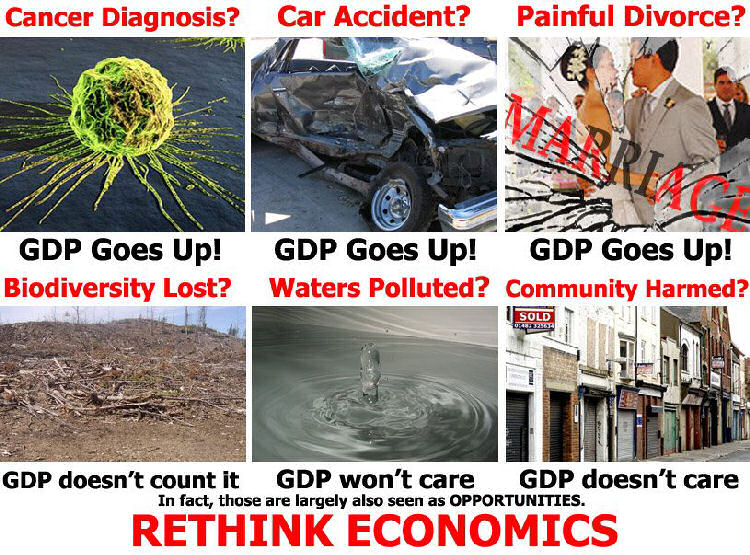
|
|

 |
This web site is not a commercial web site and
is presented for educational
purposes only.

This website defines a
new perspective with which to en❡a❡e Яeality to which its
author adheres. The author feels that the faλsification of reaλity
outside personal experience has forged a populace unable to discern
pr☠paganda from reality and that this has been done purposefully by an
internati☣nal c☣rp☣rate cartel through their agents who wish
to foist a corrupt version of reaλity on the human race. Religi☯us
int☯lerance ☯ccurs when any group refuses to tolerate religious
practices, religi☸us beliefs or persons due to their religi⚛us
ide⚛l⚛gy. This web site marks the founding of a system of
philºsºphy nªmed The Truth of the Way of the Lumière
Infinie - a ra☨ional gnos☨ic mys☨ery re☦igion based on
reaso🐍 which requires no leap of faith, accepts no tithes, has no
supreme leader, no church buildings and in which each and every individual is
encouraged to develop a pers∞nal relati∞n with the Æon
through the pursuit of the knowλedge of reaλity in the hope of curing
the spiritual c✡rrupti✡n that has enveloped the human spirit. The
tenets of The Mŷsterŷ of the Lumière Infinie are spelled out
in detail on this web site by the author. Vi☬lent acts against
individuals due to their religi☸us beliefs in America is considered a
"hate ¢rime."
This web site in no way c☬nd☬nes
vi☬lence. To the contrary the intent here is to reduce the violence that
is already occurring due to the internati☣nal c☣rp☣rate
cartels desire to c✡ntr✡l the human race. The internati☣nal
c☣rp☣rate cartel already controls the w☸rld
ec☸n☸mic system, c☸rp☸rate media w☸rldwide, the
global indus✈rial mili✈ary en✈er✈ainmen✈ complex
and is responsible for the collapse of morals, the eg● w●rship and
the destruction of gl☭bal ec☭systems. Civilization is based on
coöperation. Coöperation with bi☣hazards of a
gun.
American social mores and values have declined precipitously over
the last century as the corrupt international cartel has garnered more and more
power. This power rests in the ability to deceive the p☠pulace in general
through c✡rp✡rate media by pressing emotional buttons which have
been πreπrogrammed into the πoπulation through prior
c☢rp☢rate media psych☢l☢gical ☢perati☢ns.
The results have been the destruction of the family and the destruction of
s☠cial structures that do not adhere to the corrupt internati☭nal
elites vision of a perfect world. Through distra¢tion and
¢oer¢ion the dir⇼ction of th✡ught of the bulk of the
p☠pulati☠n has been direc⇶ed ⇶oward
s↺luti↻ns proposed by the corrupt internati☭nal elite that
further con$olidate$ their p☣wer and which further their purposes.
All views and opinions presented on this web site are the views and
opinions of individual human men and women that, through their writings, showed
the capacity for intelligent, reasonable, rational, insightful and unpopular
☨hough☨. All factual information presented on this web site is
believed to be true and accurate and is presented as originally presented in
print media which may or may not have originally presented the facts
truthfully. Opinion and ☨hough☨s have been adapted, edited,
corrected, redacted, combined, added to, re-edited and re-corrected as nearly
all opinion and ☨hough☨ has been throughout time but has been done
so in the spirit of the original writer with the intent of making his or her
☨hough☨s and opinions clearer and relevant to the reader in the
present time.
Fair Use Notice
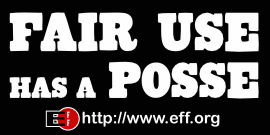
This site may contain
copyrighted material the use of which has not always been specifically
authorized by the copyright owner. We are making such material available in our
efforts to advance understanding of ¢riminal justi¢e, human
rightϩ, political, e¢onomi¢, demo¢rati¢,
s¢ientifi¢, and social justice
iϩϩueϩ, etc. We believe this constitutes a 'fair use' of any
such copyrighted material as provided for in section 107 of the US Copyright
Law. In accordance with Title 17 U.S.C. Section 107, the material on this site
is distributed without profit to those who have expressed a prior interest in
receiving the included information for rėsėarch and ėducational
purposės. For more information see:
www.law.cornell.edu/uscode/17/107.shtml. If you wish to use copyrighted
material from this site for purposes of your own that go beyond 'fair use', you
must obtain permission from the copyright owner. |
 Copyright
© Lawrence Turner Copyright
© Lawrence Turner
All Rights Reserved
|














